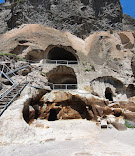Verdza , Georgia
🏰 Discover Vardzia: Georgia’s Hidden Cave City of Legends
📍 A Kingdom Carved in Stone. A Story Written in Silence.
Beneath the sun-kissed cliffs of southern Georgia lies a secret world—mystical, majestic, and carved into the mountain itself. Welcome to Vardzia, a 12th-century cave monastery that feels more like a fantasy realm than a historic site.
![Insert panoramic image of Vardzia cliffside caves here – ideally during golden hour]
✨ What Makes Vardzia So Special?
-
🕳️ Over 600 rooms carved into the cliffs—including chapels, libraries, bakeries, wine cellars, and even a throne room!
-
🖼️ Home to the fresco of Queen Tamar, one of Georgia’s most iconic figures.
-
🧭 Hidden tunnels and secret passageways that once sheltered monks and royalty.
-
⛪ A still-functioning monastery, where monks live and pray amidst the silence of stone.
📖 A Glimpse Into Georgia's Golden Age
Vardzia wasn’t just a religious site—it was a fortress, a royal palace, and a symbol of Georgia’s strength during the reign of Queen Tamar. Built into the side of Erusheti Mountain and designed to be invisible from invaders, this underground world tells tales of faith, power, and survival.
“It’s like walking through a living fairytale carved into rock.”
🧭 How to Get There
-
From Tbilisi: ~4 hours by car or guided tour
-
Nearest Town: Aspindza
-
Best time to visit: Spring (May–June) and Autumn (Sept–Oct)
🚶♂️ Don’t forget: Wear good walking shoes—there are stairs, caves, and ledges to climb!
🌄 Why Vardzia Belongs on Your Bucket List
If you crave history that whispers from the walls, scenery that stuns, and stories that stir the soul—Vardzia delivers. Whether you’re a history buff, photographer, or spiritual seeker, this cliffside city will stay in your heart long after you leave.
📸 Perfect for: Instagram-worthy views, ancient architecture, and cultural immersion.
🏰 Vardzia: Georgia’s Subterranean Masterpiece That Defied Time
📍 A Hidden World Etched into a Cliff
Vardzia isn’t just a historical monument—it’s an underground city built into the heart of a mountain, revealing a side of Georgia’s past that few places can match. Set along the Mtkvari River in southern Georgia’s Samtskhe-Javakheti region, Vardzia rises from a cliff face like an ancient mirage—mysterious, immense, and beautifully preserved.
This cave complex stretches for over 500 meters along the cliff and plunges up to 13 tiers deep into the rock. Originally constructed in the 12th century during the reign of King George III and completed by his daughter, the iconic Queen Tamar, it was both a fortress and a spiritual haven.
🧱 A City Carved, Not Built
At its peak, Vardzia had:
-
🏠 Up to 3,000 cave dwellings
-
⛪ 13 levels of rooms, including chapels, libraries, bakeries, apothecaries, a throne room, and even secret escape tunnels
-
💧 A sophisticated irrigation and water distribution system still visible today
-
🍷 Wine cellars with massive clay vats, proving that wine was sacred even in the caves!
🎨 Artistic & Religious Treasures
The crown jewel of Vardzia is the Church of the Dormition, beautifully painted with 12th-century frescoes. Among them is the famous portrait of Queen Tamar, one of the very few visual records of her. These frescoes are not just artistic achievements—they're historic narratives, telling stories of Georgia’s spiritual and political identity.
The church still functions today, and visiting it feels like stepping into a time capsule where monks chant beneath ancient ceilings.
⚔️ Earthquake, Invasion, and Rediscovery
In 1283, a massive earthquake struck the region, collapsing much of the outer wall and exposing the once-hidden monastery. Later, the Mongols and Persians invaded, yet the site persisted—partially ruined, but never forgotten.
In modern times, Vardzia has been studied, restored, and reopened, drawing thousands of visitors each year, yet still maintaining its mystical quietude.
🧘♂️ Modern Monks & Living Spirituality
Vardzia is not a museum—it’s a living monastery. A small number of Georgian Orthodox monks still live in the caves, preserving the sacred essence of the site. You might hear the sound of prayers echoing through tunnels or see candlelight flickering in a rock-cut chapel.
🌿 Nature Around Vardzia
The surrounding region is stunning:
-
Towering cliffs and deep gorges
-
The peaceful Mtkvari River flowing below
-
Nearby natural hot springs and hiking trails
-
Rustic villages where time stands still
🗺️ Extra Travel Tips
-
Combine with other attractions: Visit Rabati Castle or Sapara Monastery on the same route.
-
Stay in a guesthouse near Aspindza or Akhaltsikhe to experience local hospitality.
-
Photography alert: Sunrise and sunset over Vardzia’s cliffs are absolutely magical.
-
Fun fact: Some scholars believe Vardzia was inspired by the idea of creating a "second Jerusalem" in Georgia.
📚 Did You Know?
-
Queen Tamar was crowned King (not queen) of Georgia—highlighting her authority in a male-dominated era.
-
Vardzia’s builders carved it from the top down, not bottom-up. This allowed better structural stability.
-
Vardzia is part of Georgia’s UNESCO World Heritage tentative list.


